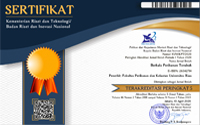Multiple Antibiotic Resistance Index of Escherichia coli Isolates from Dumai Sea Waters Riau Province
Abstract
Keywords
Full Text:
PDFReferences
Alderman, D., & Hastings, T. (1998). Antibiotic use in aquaculture: development of antibiotic resistance–potential for consumer health risks. International journal of food science & technology, 33(2), 139-155.
Amin, L. Z. (2014). Pemilihan antibiotik yang rasional. Medicinus, 27(3), 40-45.
Chang, G., & Roth, C. B. (2001). Structure of MsbA from E. coli: a homolog of the multidrug resistance ATP binding cassette (ABC) transporters. Science, 293(5536), 1793-1800.
Edgar, R., & Bibi, E. (1997). MdfA, an Escherichia coli multidrug resistance protein with an extraordinarily broad spectrum of drug recognition. Journal of bacteriology, 179(7), 2274-2280.
Feliatra, F., Mardalisa, M., Setiadi, J., Lukistyowaty, I., & Hutasoit, A. (2020). Potential of Secondary Metabolite from Marine Heterotrophic Bacteria against Pathogenic Bacteria in Aquaculture. Paper presented at the Journal of Physics: Conference Series.
Goossens, H., Ferech, M., Vander Stichele, R., Elseviers, M., & Group, E. P. (2005). Outpatient antibiotic use in Europe and association with resistance: a cross-national database study. The Lancet, 365(9459), 579-587. doi: http://dx.doi.org/10.1016/S0140-6736(05)70799-6
Hecht, D. W., Citron, D. M., Cox, M., Jacobus, N., Jenkins, S., Onderdonk, A., . . . Wexler, H. (2007). Methods for Antimicrobial Susceptibiluty Testing of Anaerobic Bacteria: Approved Standard: Clinical and Laboratory Standards Institute Wayne, PA.
Hudzicki, J. (2009). Kirby-Bauer disk diffusion susceptibility test protocol. American Society for Microbiology 1-23.
Joseph, A., Odimayo, M., Olokoba, L., Olokoba, A., & Popoola, G. (2017). Multiple antibiotic resistance iIndex of EscherichiaColi isolates in a tertiary hospital in south-west Nigeria. Medical Journal of Zambia, 44(4), 225-232.
Kehrenberg, C., Schwarz, S., Jacobsen, L., Hansen, L. H., & Vester, B. (2005). A new mechanism for chloramphenicol, florfenicol and clindamycin resistance: methylation of 23S ribosomal RNA at A2503. Molecular microbiology, 57(4), 1064-1073.
Klein, E. Y., Van Boeckel, T. P., Martinez, E. M., Pant, S., Gandra, S., Levin, S. A., . . . Laxminarayan, R. (2018). Global increase and geographic convergence in antibiotic consumption between 2000 and 2015. Proceedings of the National Academy of Sciences, 115(15), E3463-E3470. doi: http://dx.doi.org/10.1073/pnas.1717295115
Krisnaningsih, M. F., Asmara, W., & Wibowo, M. H. (2005). Uji Sensitivitas Isolat Escherichia Coli Patogen pada Ayam terhadap Beberapa Jenis Antibiotik. Jurnal Sain Veteriner, 23(1).
Mardalisa, M., Suhandono, S., & Ramdhani, M. (2020). Isolation and Characterization of str Promoter from Bacteria Escherichia coli DH5α using Reporter Gene AmilCP (Acropora millepora). Paper presented at the IOP Conference Series: Earth and Environmental Science.
McDanel, J., Schweizer, M., Crabb, V., Nelson, R., Samore, M., Khader, K., . . . Nair, R. (2017). Incidence of extended-spectrum β-lactamase (ESBL)-producing Escherichia coli and Klebsiella infections in the United States: a systematic literature review. infection control & hospital epidemiology, 38(10), 1209-1215.
Nikaido, H. (2009). Multidrug resistance in bacteria. Annual review of biochemistry, 78, 119-146. doi: http://doi.org/10.1146/annurev.biochem.78.082907.145923
Patel, J. B., Tenover, F. C., Turnidge, J. D., & Jorgensen, J. H. (2011). Susceptibility test methods: dilution and disk diffusion methods Manual of Clinical Microbiology, 10th Edition (pp. 1122-1143): American Society of Microbiology.
Permenkes, R. (2015). Program Pengendalian Resistensi Antimikroba di Rumah Sakit.
Phares, C. A., Danquah, A., Atiah, K., Agyei, F. K., & Michael, O.-T. (2020). Antibiotics utilization and farmers’ knowledge of its effects on soil ecosystem in the coastal drylands of Ghana. PloS one, 15(2), e0228777. doi: http://dx.doi.org/10.1371/journal.pone.0228777
Pradipta, I. S., Febrina, E., Ridwan, M. H., & Ratnawati, R. (2012). Identifikasi pola penggunaan antibiotik sebagai upaya pengendalian resistensi antibiotik. Indonesian Journal of Clinical Pharmacy, 1(1), 16-24.
Sagala, T. R., Supono, S., & Harpeni, E. (2020). Effect Biofloc System and Probiotics Bacillus sp. D2. 2 that non Specific Immune Response of Tilapia Oreochromis niloticus (Linn, 1758) Infected by Aeromonas hydrophila. Berkala Perikanan Terubuk, 48(1), 309-319. doi: DOI: http://dx.doi.org/10.31258/terubuk.48.1.309-319
Sharma, P., Mathur, N., Singh, A., Sogani, M., Bhatnagar, P., Atri, R., & Pareek, S. (2015). Monitoring hospital wastewaters for their probable genotoxicity and mutagenicity. Environmental monitoring and assessment, 187(1), 4180.
Silver, L., Chandler, M., de la Tour, E. B., & Caro, L. (1977). Origin and direction of replication of the drug resistance plasmid R100. 1 and of a resistance transfer factor derivative in synchronized cultures. Journal of bacteriology, 131(3), 929-942.
Sitorus, N. K., Lukistyowati, I., Syawal, H., & Putra, I. (2019). Identification of Lactic Acid Bacteria from Bioflok Technology which has been Gave Mollases on Red Tilapia (Oreochromis sp.) Aquaculture. Berkala Perikanan Terubuk, 47(1), 83-92. doi: DOI: http://dx.doi.org/10.31258/terubuk.47.1.83-92
Skariyachan, S., Lokesh, P., Rao, R., Kumar, A. U., Vasist, K. S., & Narayanappa, R. (2013). A pilot study on water pollution and characterization of multidrug-resistant superbugs from Byramangala tank, Ramanagara district, Karnataka, India. Environmental monitoring and assessment, 185(7), 5483-5495.
Supendi, A. (2016). Dampak Aktivitas Antropogenik pada Daerah Aliran Sungai terhadap Produktivitas Tambak di Perairan Pesisir. Paper presented at the Seminar Nasional PBI 2016.
Utami, E. R. (2012). Antibiotika, resistensi, dan rasionalitas terapi. Sainstis.
Vila, J., & Pal, T. (2010). Update on antibacterial resistance in low-income countries: factors favoring the emergence of resistance. The Open Infectious Diseases Journal, 4(1), 38-54. doi: http://dx.doi.org/10.2174/1874279301004010038
Wayne, P. (2010). Clinical and Laboratory Standards Institute: Performance standards for antimicrobial susceptibility testing: 20th informational supplement. CLSI document M100-S20.
DOI: http://dx.doi.org/10.31258/terubuk.49.1.734-739
Refbacks
- There are currently no refbacks.
Copyright (c) 2021 Mardalisa Mardalisa, Feliatra Feliatra, Nursyirwani Nursyirwani

This work is licensed under a Creative Commons Attribution 4.0 International License.












